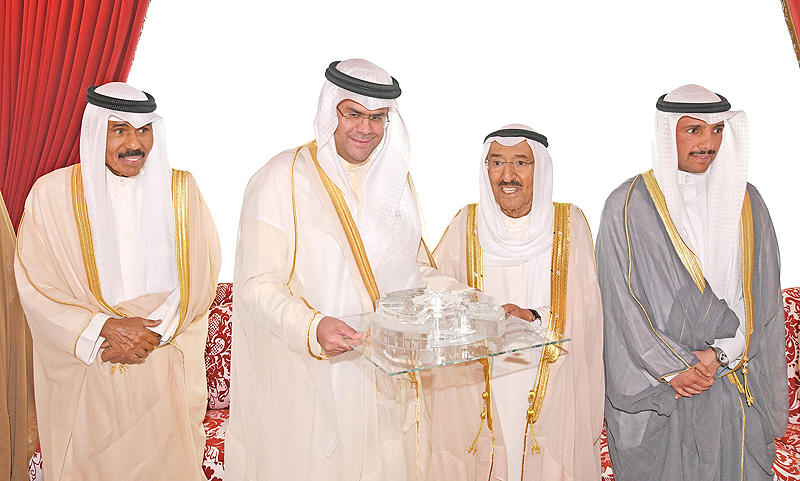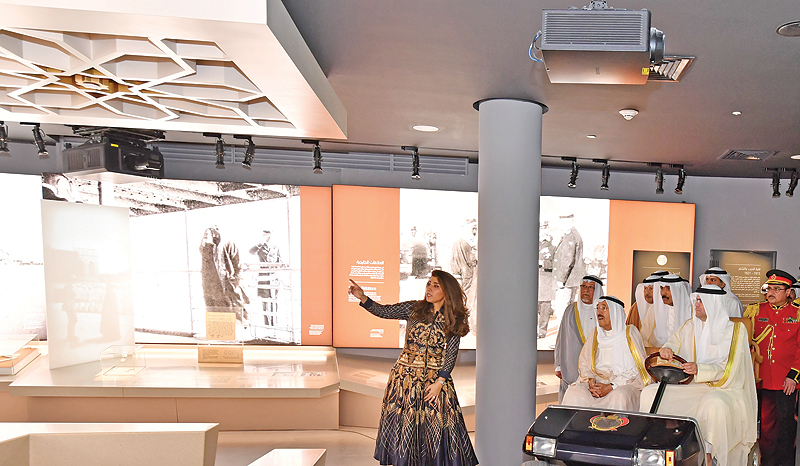Palace documents country's history in innovative style: Official

KUWAIT: His Highness the Amir Sheikh Sabah Al-Ahmad Al-Jaber Al-Sabah inaugurated the 'Salam Palace' Museum yesterday. Upon arriving to the venue, His Highness was received by Minister of Amiri Diwan Affairs Sheikh Ali Jarrah Al-Sabah, as well as Abdulaziz Ishaq, Head of Finance and Administrative Affairs of the Amiri Diwan and Chairman of the Executive Committee for the Establishment and Management of Cultural Centers. The ceremony was also attended by His Highness the Crown Prince Sheikh Nawaf Al-Ahmad Al-Jaber Al-Sabah, National Assembly Speaker Marzouq Al-Ghanem and His Highness the Prime Minister Sheikh Jaber Al-Mubarak Al-Hamad Al-Sabah, in addition to a host of senior state officials .Following a speech by Minister of Amiri Diwan Affairs, His Highness toured the Museum, where he was briefed with its main sections and facilities before leaving the site just as warmly welcomed.
Innovative style
The 'Salam Palace' Museum is a cultural edifice that documents Kuwait's history in an innovative style, Ishaq said, adding that this unique building houses a collection of rare artifacts and preserve the national cultural heritage of Kuwait. The Museum has been designed to suit the modern generation provided with the latest technological display methods to presents the history of Kuwait and the civilizations it has undergone to the visitor in a creative and innovative manner, without any dazzling fun, he clarified.
The Palace, which represents great historical and national value in the hearts of Kuwait's rulers and people, was rehabilitated upon instructions of His Highness the Amir to turn it into a museum that documents the country's history, Ishaq explained. The reconstruction process comes within the concept of new cultural-oriented and historical dimensions by turning it into a museum comparable to the finest and high standers international museums. It consists of four floors (basement - ground - first - second), where the basement includes an electronic library connected to the Central Library of the Amiri Diwan, as well as areas dedicated to scientific research and staff offices, storage and service rooms plus others.
The ground floor is located on Jamal Abdelnasser Street with a VIP entrance overlooking the Arabian Gulf Road. It also includes exhibition halls for the "History of the Palace" that reflects the original construction of the Palace, as well as dignitaries who visited and stayed in it. The first floor contains the museum (the history of Kuwait through its rulers), which includes nine halls that tell the history of Kuwait since its inception, with most important achievements made during the history of the 15 rulers of Kuwait, with a display of their collectibles and personal items. The second floor includes a reception areas, a banquet hall and a central kitchen. The Palace is divided into three main sections; the Museum of Kuwait History through its rulers, the Peace Palace History Museum, and the Museum of Civilizations that inhabited the land of Kuwait. Ishaq pointed to other sections that have been developed to serve the Museum, including a special suite to receive senior guests of the state, a digital library, educational halls for school students, and a "Courtyard" with multi-parking.
Building's history
Construction of the property, which was the private residence of Late Father Amir Sheikh Saad Al-Abdullah Al-Salem Al-Sabah, began in the late 1950s. In 1960, the basic construction of the Palace started, coinciding with the independence of Kuwait in 1961. At the time, Kuwait was in need of a guesthouse for officials visiting the country and a place to hold State-level meetings and international discussions.
The ownership of the Palace transferred to the state, and converted into a guesthouse under the supervision of the late Sheikh Jaber Al-Ahmad Al-Jaber Al-Sabah; back then minister of finance. The Palace received its first visitor in 1964, and then started to receive kings, emperors, and officials who reached 166. In 2013, Sheikha Mona Al-Jaber Al-Sabah proposed, after 23 years of neglect, to the Minister of Amiri Diwan Affairs, Chairman of the Higher Committee of Cultural Centers, to create a museum that combines the history of Kuwait for the first time and is kept under one roof. The reconstruction process took nearly six years that will demonstrate 300 years of undocumented history of Kuwait. - KUNA











